I am trying to extract data from a netcdf file using wrf-python. The data is for every hour. The date is being extracted as a number, and not a calendar-date-time. First I extract the data, convert it to a flat np array, then try to save the file. The format is saved as '%s'
np.savetxt((stn + 'WRF_T2_T10_WS_WD.csv'), np.transpose(arr2D), %s, delimiter=',', header=headers, comments='')
it looks like this: 
but it needs to look like this: 
Thanks